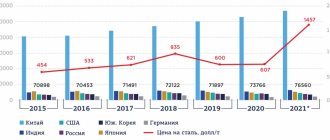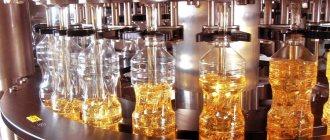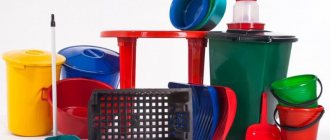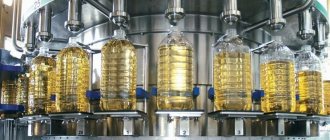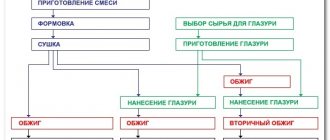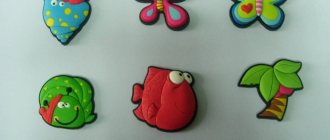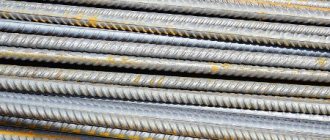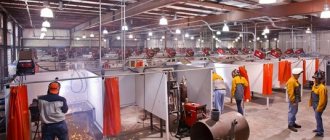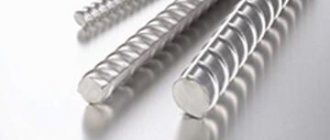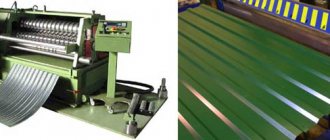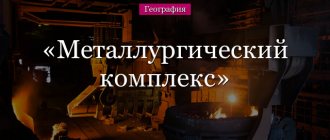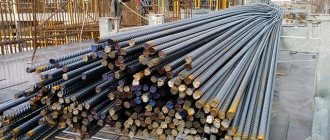For a novice entrepreneur, the production of fiberglass fittings is one of the promising options for starting a business. Since it does not require huge capital investments and labor costs.
Of course, today the construction industry uses a lot of materials, the production of which can make good money.
If you set up a business in the production of composite reinforcement of the appropriate quality, with the appropriate organization of production and a well-developed clientele, then you can quickly return the initial costs and receive net revenue within the next 2-3 years after opening.
At its core, fiberglass or composite reinforcement is a bundle of solid glass fibers characterized by high strength. The finest threads are connected to each other using synthetic resin to form a strong rod.
Such products are usually used in the field of construction production and finishing or in everyday life (for example, for assembling greenhouses). In addition, unlike metal reinforcement, fiberglass products are not welded, but are held together with special fasteners (clamps).
Also, fiberglass (composite) reinforcement is known as “non-metallic”.
Equipment for the production of composite reinforcement
Where to start a business producing fiberglass reinforcement
Assessing the business for the production of fiberglass reinforcement, we can say the following:
- The market saturation is still at an average stage and still has free niches for new entrepreneurs to fill.
- The difficulty of opening on a 10-point scale is 6 points.
Of course, for the long-term development of a business, it is necessary first of all to purchase high-quality and guaranteed equipment. By purchasing it, setting up and launching production, you can supply the market with in-demand fiberglass (composite) reinforcement, both to small private builders and large construction companies.
At the same time, even with a small investment, paperwork and choice of location for the workshop, for successful development of business in this field, it is necessary to carefully work out a business plan for the production of fiberglass reinforcement, in which the following points must be taken into account:
- analytical forecast of market development and competitive base in this area;
- production technology;
- technical equipment of workshop premises;
- financial justification for the production of products from fiberglass reinforcement.
Differences from large enterprises
The popularity of mini-mills in the valve production sector is explained by a number of advantages that distinguish them from integrated large metallurgical plants:
- Low costs due to small production areas. Reducing the financial burden is also facilitated by the possibility of locating small factories in places where there is a sufficient amount of raw materials. If necessary, production lines can be set up close to the main consumers of fittings, receiving economic benefits by reducing transport costs and eliminating the need to have large warehouses for storing products.
Scheme of production at integrated and mini valve plants - Causes less harm to the environment.
- Flexibility in the use of equipment. Electric arc furnaces make it possible to produce a planned amount of products and then stop them. The subsequent launch of production does not require additional investment. This circumstance allows us to quickly respond to changing market needs.
- Simplification of production due to the fact that the cast blanks are almost identical in basic dimensions to the manufactured fittings, so only minor modifications are required at the finishing stage.
Thanks to the short technological process, the mini-plant allows you to focus on a specific customer, producing in small batches the range of fittings he needs.
How much can you earn from a business producing fiberglass reinforcement?
For example, with an average productivity of 150 thousand running meters. finished monthly product, its cost on the large wholesale market will be about 6-10 rubles per linear meter, with revenue of 1.5 million rubles. At the same time, in order to reach the net profit figure, it will be necessary to calculate from the total revenue variable costs for the purchase of raw materials, payment of taxes and wages to employees, as well as costs for communications, transport and utility bills.
From practice, it becomes obvious that the monthly net revenue of the enterprise will be about 100,000 rubles, that is, in such a favorable situation, the payback of the business will be 2-2.5 years.
All these indicators, with full sales of products, must be calculated in the business plan. Since in this case it will be clear whether production is profitable or not.
Cost calculation, payback
To determine the average cost of finished products and payback, a mini-plant with a production volume of various types of fittings of 5400 tons/month is considered.
Capital investments, taking into account the construction of workshops, which will require an area of about 61 hectares, and the purchase of equipment from the Turkish company PIRMER MAKINA, will amount to approximately 958,000 thousand rubles.
When ensuring the quality of fittings, you have to incur certain costs for materials
Work organization: two shifts of 12 hours for 25 days a month. It is planned to produce 35GS fittings. To obtain this grade, you will need ferroalloys.
To produce one ton of reinforcement, 1057 kg of charge must be loaded into the melting furnace.
Approximate monthly expenses, thousand rubles:
- wage fund – 1760;
- steel scrap – 40,000;
- ferroalloys – 4500;
- additional materials (lumpy lime, fluorspar, coke) – 330;
- consumables (quartz sand, boric acid, ground quartzite, lining, oil for hydraulic systems, lubricant) – 4425;
- electricity, water supply, compressed air, oxygen – 12160;
- repair fund, depreciation – 4700.
The total production cost is 67,875 thousand rubles per month.
Production cost schedule
Income is calculated based on the market value of one ton of reinforcement with a diameter of 12 mm, which is equal to 26 thousand rubles.
Total income:
- 26 ∙ 5400 = 140400 thousand rubles.
Profit:
- 140400 – 67878 = 72525 thousand rubles.
Net profit (taking into account 15% tax):
- 72525 – 10878 = 61647 thousand rubles.
Payback:
- 958000 / 61647 ≈ 15.5 months.
As calculations show, mini-reinforcement factories with large initial financial investments can be profitable if the overall strategy for their operation is correctly determined.
What equipment to choose for the production of fiberglass reinforcement
Since the production of fiberglass reinforcement uses special equipment that must be maintained and operated under certain conditions, when starting a business you must understand and know what it includes and what parameters of the premises conditions will need to be taken into account when producing fiberglass building material.
So, the equipment for the production of composite reinforcement includes the following list of key points:
- creel, which is a machine for unwinding roving threads (fiberglass threads or basalt fiber);
- impregnation device for impregnation of threads with binder material;
- an impregnation bath that will contain a special mixture based on epoxy resin;
- rib wrapper, device for forming a profile and twisting the thread;
- thermal polymerization chamber;
- devices for cooling fittings;
- pulling device;
- a device for winding reinforcement onto a drum or cutting device;
- computerized line control system.
Such a technological production line can be set up in one or two streams. At the same time, upon delivery of the ordered equipment, it is recommended to purchase a set of technological and technical documentation, and install and commissioning work with the launch of a trial batch, selection of recipes and technological parameters for the production of composite reinforcement, taking into account individual production conditions, and training of service personnel to include in the cost of the order.
The conditions for the premises in the production of fiberglass reinforcement are as follows:
- The air temperature should be from +16 to +20ºС.
- The room must have a height of 250cm and above, with a minimum length and width of 25x4m.
- The production workshop must be equipped with an exhaust ventilation and fire extinguishing system, with access and water flow of at least 0.5 m3/h.
If all indicators are met, as well as the data specified in the business plan for the sale of composite reinforcement, designed for high profitability, under the conditions of 100% sales of goods and the maintenance of packages of documents in the proper order, it is quite realistic and profitable to open the production of reinforcement. Good luck!
Areas of application
Among the main areas of application of composite reinforcement are:
- when laying roads, building airfields and bridges;
- for reinforcing strip foundations, for strengthening walls and partitions
- in industry to create structures that are resistant to corrosion and aggressive environments, when stringent requirements are imposed on the strength characteristics;
- in agriculture during the construction of livestock complexes and various facilities;
- to restore partially damaged or destroyed brick structures;
- during the formation of water channels, sewerage and drainage systems;
- for strengthening river banks, during the construction of ports and coastal structures.
Examples of the use of fiberglass reinforcement.
Since fiberglass reinforcement belongs to hazard class 4, it can be used for other purposes, provided that the material meets the requirements.
Production technology of composite reinforcement
Composite reinforcement is a popular building material. But you shouldn’t count on excess profits in the first months of work. Regular customers appear over time. If we talk about the production process, it is worth noting that it consists of several stages:
- Impregnation of fiberglass threads with polymer resin;
- Giving the raw material the appearance of a rod;
- Polymerization;
- Winding and fastening of the profile.
The fiberglass product is produced using special equipment using an automatic method. The entire manufacturing process is controlled using a computer.
0
Step-by-step launch instructions
To start production, you must complete the following tasks:
- Drawing up a business project.
- Careful study of product manufacturing technology.
- Selection of a room whose length is 25-30 meters, the ceiling height is at least 3 meters. In addition, it is important that the height fluctuation is no more than 5 centimeters. It is also recommended to control the air temperature, which should be 16-200 C. Additionally, care should be taken to have a spacious warehouse.
- Purchase of special equipment - the brand and model are selected taking into account the scale of the project.
- Preparation of necessary raw materials:
- roving;
- connecting threads;
- synthetic resin;
- dicyandiamide;
- acetone;
- ethyl.
Legal registration
To engage in the production of construction fittings from unalloyed and alloyed steel, you must register a business by contacting the tax office at your place of residence. Since rolled metal requires serious investments, and to sell it you will have to enter into deals with wholesale suppliers and buyers, it is advisable to open an LLC - the status of a legal entity inspires more confidence among customers and banks than an individual entrepreneur. For registration you will need:
- title document confirming the rights to own real estate at the legal address;
- copies of statutory documents and their originals;
- receipt of payment of state duty (RUB 4,000).
Important! If the plant’s income for the reporting period does not exceed 150 million, and the staff is less than 100 people, then a simplified taxation system will be optimal (15% of profit or 6% of income). Otherwise (if the income is higher, the staff is larger) you will have to choose OSNO.
OKVED code 25.1 – production of building metal structures. For wholesale trade, OKVED 46.74 is indicated. In your activities you will have to be guided by GOST:
- 34028-2016 – rolled reinforcement for reinforced concrete structures;
- 5781-82 – hot-rolled steel for reinforcement of reinforced concrete structures.
In accordance with Russian legislation, construction reinforcement is not subject to mandatory certification (PP No. 982 dated December 1, 2009), but a certificate can be issued on a voluntary basis. This will increase the degree of confidence in the product.
Product Features
Reinforcing bars strengthen and improve the properties of concrete. According to production technology, it can be cold-rolled and hot-rolled, and according to the area of application - transverse and longitudinal. The following are used in construction:
- clamps;
- installation, distribution, working fittings.
The clamp connects the rods into a single frame. Working reinforcement minimizes stress from the weight of the block and reduces the influence of external loads, distribution reinforcement distributes the load, assembly reinforcement (piece or in the form of a mesh) is used to assemble the frame and reinforce the slabs.
Reinforcing bars are supplied in rods and coils. Thermally strengthened reinforcement is obtained by hardening. Hot-rolled metal does not require hardening (strength is ensured by the chemical composition). Cold processing is performed by two methods:
- drawing involves repeated pulling through a die (a cone-shaped hole);
- force calibration consists of stretching the material by 6-8% (a special installation is used).
In the first case, strength increases by 60%, in the second - by 20-25%. The fittings are marked with the letters:
- reinforced by hood – “B”;
- thermally durable - “T”;
- corrosion resistant – “K”;
- withstands welding - “C”.
According to their shape, metal products are divided into smooth (no notches on the surface) and periodic profiles (with notches or corrugations that improve adhesion to the material).
Raw materials
Mini-productions can only work with several categories of metal scrap - these are:
- pig iron (90-96% iron);
- scrap HMS1 (heavy melting), shredder (high bulk density) or steel lump (category 3A);
- reduced iron PVZh/GVZh.
In addition to scrap, coke, ferroalloys, ground quartzite, fluorspar, lump lime, boric acid, quartz sand, lining, and other consumables are needed.
